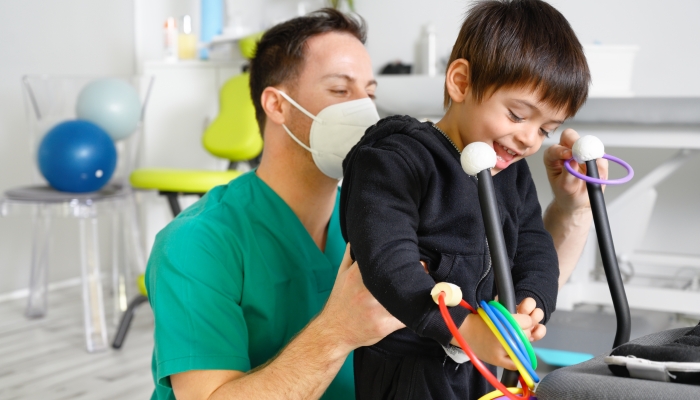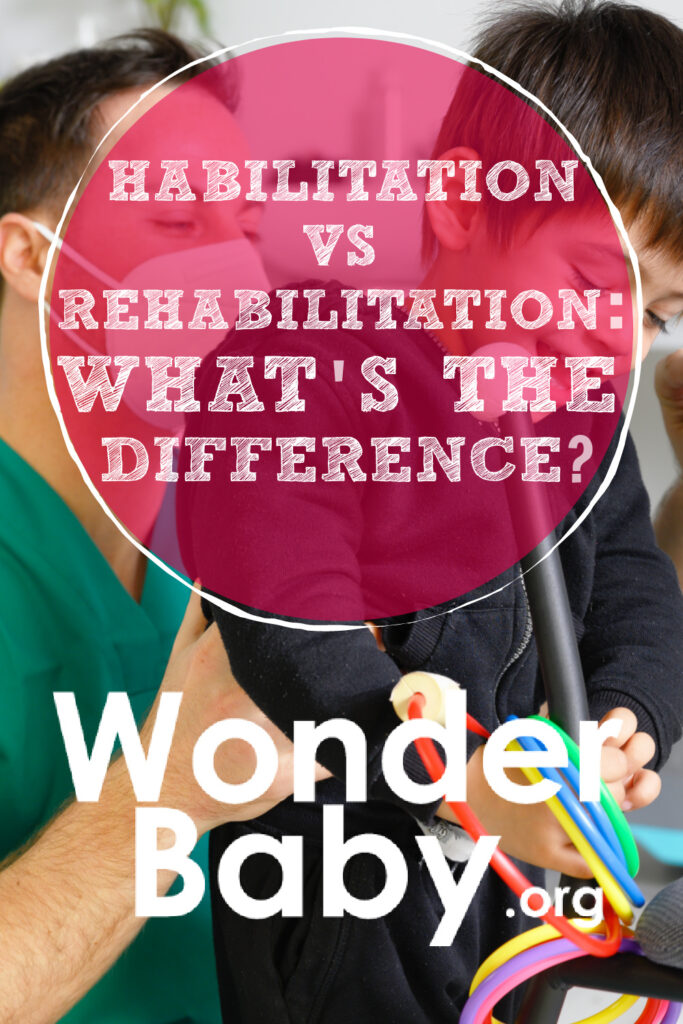Habilitation vs Rehabilitation: What’s the Difference?

- Habilitation is the process of gaining, keeping, and improving new skills. Rehabilitation is the process of returning to a prior skill level.
- Habilitation and rehabilitation refer to therapy areas within healthcare as well as community resources and programs.
- There may be a lot of overlap between habilitative and rehabilitative services. Differences can be found in the population treated and where the patient is in the process of learning to do new tasks.
Have you heard of these two very similar words: habilitation and rehabilitation? You may wonder what the difference is and why that difference matters.
For parents of an adult or child with special needs, the difference between habilitation and rehabilitation is important. It can influence what kind of services your child receives and how those services are covered by insurance.
What is Habilitation?
Habilitation refers to gaining adaptive skills for a person to increase their overall independence. For adults, services are considered habilitation if the person has a physical or cognitive disability. For children, habilitation may address disabilities or developmental delays where children are not obtaining motor or other skills by an expected age.
While habilitation addresses learning new skills, habilitation services also includes treatment to improve skills and maintain, or prevent the loss of, existing skills and knowledge in differently abled individuals.
For instance, children with cerebral palsy may first learn transfers, brushing teeth, or other activities of daily living in outpatient therapy and then continue to address any difficulties that arise with these skills throughout their lives. As they grow up, they may need to learn more functional skills, like performing job-related tasks, and may reenter a habilitation program.
Habilitation is more likely in community settings like day programs, residential communities, or adult job training centers. It may also be seen in typical healthcare settings—inpatient and outpatient.
Children may receive habilitation services in both community and healthcare settings but are most likely to receive them in outpatient, school, or home settings. Habilitation in healthcare settings may involve working with physical therapists, occupational therapists, speech-language pathologists, psychiatrists and mental health therapists, and audiologists.

Examples of Habilitation Services
| Setting | Description |
| Health Care | Licensed professionals provide services considered medically necessary and typically billable to insurance |
| Outpatient | Outpatient services are provided for non-admitted patients (patients with stable medical status) in pediatric or orthopedic clinics and home health settings. These services may be given on a long-term basis. |
| Inpatient | Refers to patients admitted to a health care facility for medical concerns and requiring nursing care and physician supervision. Services are provided in hospitals, skilled nursing or rehabilitation centers, or long-term care facilities. These services would only be considered habilitation for adults with a new or existing disability or children with a disability or developmental delay. |
| Community | Services are provided to address functioning within the community, like learning activities of daily living or other skills that improve independence. Parts of these programs may be billable to insurance (if provided by a healthcare professional), or funding may be found through nonprofit, local, or state resources. |
| Public Schools or Daycare | Therapies are often provided in daycare to children with developmental delays. In the school system, these services are intended to help children learn adaptive or new skills to access the school environment and receive an education. |
| Residential | Adults with special needs may live in residential settings that offer varying degrees of independence with assistance or nursing care available. Children in residential settings typically have severe disabilities or attend specialized schools, such as schools for the deaf or blind. Services covered by insurance are more likely in these community settings since there is often health care like therapy and nursing involved. |
| Day Programs | Day programs are essentially supervised care for adults with disabilities provided during working hours to give families respite. Many day programs provide education on life skills like cooking, socialization, and personal care. |
| Job Training | Job training programs provide education and training to help adults with disabilities obtain new skills to find jobs and increase their independence. These programs are more likely to be staffed by career coaching and mental health or social work professionals than therapists, though occupational therapists may be involved. |
What is Rehabilitation?
Rehabilitation is what people typically think of when they think of therapy services. In the healthcare world, this refers to a person returning to their prior level of function after a decline in health, often due to injury, illness, or disease. Instead of learning brand-new skills, a person receiving rehabilitation services will relearn skills they previously knew how to do.
For instance, after a traumatic car accident resulting in a broken leg and arm, a person may relearn how to walk in physical therapy and how to bathe in occupational therapy. Similarly, a person may relearn to speak and swallow in speech-language pathology after a stroke.
The “relearning” may not be literally learning the skill again step by step (though this may be the case!). It often means that motor skills must be practiced to perform them again safely, independently, and without using poor movement patterns.
Ideally, a person in rehabilitation due to changes in their health status will be able to perform skills at the same level they were able to previously once they complete their treatment. The nature of their injury or illness often dictates how long the rehabilitation process takes, sometimes requiring only weeks of health care services and other times requiring several years of treatment.
Your child may require rehabilitation services after a broken bone, sprain, brain injury, recovery from a hospital stay, or a variety of other reasons. For incidents that constitute a major life change, your child may require long-term rehabilitation services (e.g., traumatic brain injury, spinal cord injury, during or after oncology treatments).
Examples of Rehabilitative Services
| Setting | Description |
| Outpatient | Therapy services in stand-alone clinics, daycares, or in the patient’s home that are intended to return the patient to their previous level of function. At this stage, the patient is often the closest to being fully discharged from therapy after an illness or injury. |
| Inpatient | Patients receive therapy services for medical reasons when admitted to a hospital, rehab, or long-term care center. Therapy may be intensive at this stage and provided daily to improve the patient’s functioning as quickly as possible. Typically services in the inpatient setting are meant to increase safety and independence with basic mobility, self-care, and speech and swallowing skills—foundational skills necessary to be discharged home with as little assistance as possible. |
| Residential | Rehabilitation services in a residential setting are typically for adults facing addiction problems, mental health problems, or returning to the community after prison. These other services are intended to reintegrate the person into their community and families. Mental health professionals typically provide these kinds of rehabilitation services. Rehabilitation here may also refer to an adult or child with special needs who is discharged home to a residential setting after a change in medical status, but still requires therapy to return to their prior level of function. |

Habilitation vs Rehabilitation: Let’s Compare
Habilitation and rehabilitation often overlap, from the settings to the types of skills addressed and interventions provided.
Insurance and Providers
Both habilitation and rehabilitation are now considered essential health benefits under the American Healthcare Act, so insurance coverage has become more widely available. Physical and occupational therapy and speech-language pathology offer both habilitation and rehabilitation, and some providers, particularly in pediatrics, regularly provide both services.
Adaptive Equipment
Habilitation and rehabilitation may involve obtaining and learning how to use adaptive equipment that assists a person in functioning independently. Adaptive equipment might include wheelchairs, prosthetics, communication devices, splints, crutches, and reachers.
Education on adaptive equipment would be considered habilitation for a patient with a new or existing disability. It would be considered rehabilitation when education on adaptive equipment is given to an adult recovering from an injury or illness and likely will only need the device temporarily.
Interventions
The interventions provided to learn or relearn tasks that affect function and daily living may also overlap and be similar between rehabilitation and habilitation.
For instance, occupational therapists teach activities of daily living, and physical therapists will provide strengthening and gait training under the umbrella of either service. A speech therapist may address articulation with a child learning to speak for the first time or an adult relearning to speak clearly after hearing loss.
However, the strategies a therapist uses to implement these interventions may be different in habilitation versus rehabilitation.
In rehabilitative services, the patient already knows how to do the task, so the provider may focus on helping the patient move appropriately so as not to cause further injury. Or they may need to give the patient adaptive strategies to perform the task as they heal.
In habilitative services, the patient is starting from square one and must learn not only what the task is, but also the motor skills to be successful. This typically involves a lot of repetition and hands-on assistance from the patient’s therapist. It may require that the therapist test out different learning strategies and ways to teach the task until the patient understands what they are trying to do.
FAQs
Does health insurance cover habilitative services? What about rehabilitative services?
Health insurance typically covers rehabilitative services for any age group if it is considered medically necessary treatment. However, the number of visits and amount of coverage varies widely across private and federally funded plans. It may also be different for children (ages birth to 21) and adults regardless of disability status.
Habilitative services are covered under the American Healthcare Act when they may not have been previously. However, this is only sometimes implemented consistently despite being considered essential health benefits. Contact your insurance provider directly to discuss coverage of these services.

The information WonderBaby provides is not intended to be, and does not constitute, medical or other health advice or diagnosis and should not be used as such. Always consult with a qualified medical professional about your specific circumstances.
Related Posts

Eye Conditions and Syndromes, Visual Impairment
Neuralink Announces Plans to Restore Sight to the Blind with Brain Chip
Elon Musk’s company Neuralink has announced plans to begin human trials of its new “Blindsight” brain chip by the end of 2025.

Special Needs
5 Spring Cleaning Tips for Families of Children with Disabilities
Spring cleaning is an opportunity to create a more accessible, organized, and supportive space for your child with disabilities. Declutter, deep clean, and refresh!

Visual Impairment
The Gift of Understanding: How a Young Child Helps His Blind Father Navigate Life
When a parent is blind, it’s natural for people to wonder how their sighted child will adapt. Will they struggle to understand their parent’s needs? Will they feel burdened by...